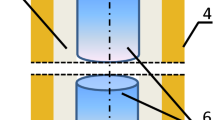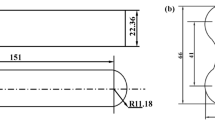Abstract
In this work, plaster molds for investment casting, reinforced with short polypropylene fibers, were prepared and their properties and fracture surface features were investigated. Fiber contents ranging from 0.10 to 0.50 wt% were introduced into a powder mixture of gypsum and mullite (ratio of 3:7) as reinforcements in order to prepare thin-walled plaster molds with high strength and permeability. The strength of green and fired plaster mold specimens was tested, the permeability was also tested, and their fracture surfaces were observed by scanning electron microscopy (SEM). The results show that the strength of the molds increases initially and then decreases with increasing fiber content. The green flexural strength of the specimens containing 0.20 wt% polypropylene fibers reached the maximum, c.a. 1.94 MPa, increased by 36.6%, and particularly, there was a slight increase in their fired strength, a maximum value of 0.45 MPa, in comparison with the fiber-free specimen. This low increase in the fired strength the reinforced specimen will produce a favorable effect on the collapsibility of shells in the casting cleaning process. In addition, the fired permeability of fiber-reinforced fired specimens exhibited significant enhancement, compared to that of the unreinforced ones. With increasing fiber content, the permeability of specimens increased from 8.6 to 11.5%. The improvement of green permeability was limited substantially. SEM observations indicate that the failure of the green specimens is a result of brittle fracture of the plaster substrate and/or fiber debonding from the matrix during loading. On the contrary, in fired specimens, the failure occurs by holes in the plaster substrate resulted from fiber ablation in the matrix during the firing process. The arrangement of polypropylene fibers can also affect the fracture behavior of molds. This proposed approach can reduce mold thickness without loss of strength and provide defined judgment basis for fracture features.














Similar content being viewed by others
References
D. Singh, R. Singh, K.S. Boparai, Development and surface improvement of FDM pattern based investment casting of biomedical implants: a state of art review. J. Manuf. Process. 31, 80–95 (2018)
L. Rakoczy, R. Cygan, Analysis of temperature distribution in shell mould during thin-wall superalloy casting and its effect on the resultant microstructure. Arch. Civ. Mech. Eng. 18(4), 1441–1450 (2018)
T. Phetrattanarangsia, C. Puncreobutra, A. Khamkongkaeo et al., The behavior of gypsum- bonded investment in the gold jewelry casting process. Thermochim. Acta 657, 144–150 (2017)
H. Jafari, M.H. Idris, A. Ourdjini et al., An investigation on interfacial reaction between in situ melted AZ91D magnesium alloy and ceramic shell mold during investment casting process. Mater. Chem. Phys. 138(2–3), 672–681 (2013)
S. Jones, C. Yuan, Advances in shell moulding for investment casting. J. Mater. Process. Technol. 135(2–3), 258–265 (2003)
Z. Harun, N.H. Kamarudin, H.M. Taib, Effect of rice husk on fired ceramic shell strength. Adv. Mater. Res. 795(1), 732–737 (2013)
K. Asaoka, J.Y. Bae, H.H. Lee, Porosity of dental gypsum-bonded investments in setting and heating process. Dent. Mater. J. 31(1), 120–124 (2012)
S.S. Bobby, S. Singamneni, Influence of moisture in the gypsum moulds made by 3D printing. Proc. Eng. 97, 1618–1625 (2014). https://doi.org/10.1016/j.proeng.2014.12.312
K. Lü, X. Liu, Z. Du, Effects of firing temperature and time on hybrid fiber-reinforced shell for investment casting. Int. J. Metalcast. 13(3), 673 (2019)
L. Gang, J. Chaozhong, Y. Qingsong et al., Influence of ceramic fiber length on flexural strength and permeability of composite investment casting shell. J. Compos. Mater. 34(4), 637–644 (2017)
Z. Huanqi, L. Guozhong, Mechanics performance of hybrid fiber reinforced cement-based composites. Acta Compos. Mater. Sin. 31(1), 140–145 (2014)
C. Yuan, W. Chen, T.M. Pham et al., Bond behavior between basalt fibres reinforced polymer sheets and steel fibres reinforced concrete. Eng. Struct. 176, 812–824 (2018)
H. Xiaobing, S. Qiang, Early strength and fracture properties of PP fiber reinforced self-consolidating concret. J. Huazhong Univ. Sci. 41(3), 115–121 (2013)
J. Feng, Y. Su, C. Qian, Coupled effect of PP fiber, PVA fiber and bacteria on self-healing efficiency of early-age cracks in concrete. Constr. Build. Mater. 228, 116810 (2019)
Y. Hao, L. Cheng, H. Hao, M.A. Shahin, Enhancing fiber/matrix bonding in polypropylene fiber reinforced cementitious composites by microbially induced calcite precipitation pre-treatment. Cement Concr. Compos. 88, 1–7 (2018)
G. Danying, L. Han, Y. Fan, Performance of polypylene-steel hybrid fiber reinforced concrete after being exposed to high temperature. Acta Compos. Mater. Sin. 30(1), 187–193 (2013)
M. Singh, M. Garg, Fibre reinforced gypsum binder composite its microstructure and durability. Mater. Struct. 33, 525–528 (2000)
Y. Qin, X. Zhang, J. Chai et al., Experimental study of compressive behavior of polypropylene-fiber-reinforced and polypropylene-fiber-fabric-reinforced concrete. Constr. Build. Mater. 194, 216–225 (2019)
S. Deb, N. Mitra, S.B. Majumder, S. Maitra, Improvement in tensile and flexural ductility with the addition of different types of polypropylene fibers in cementitious composites. Constr. Build. Mater. 180, 405–411 (2018)
Y. Li, X. Liu, K. Lű et al., Preparation of fiber-reinforced shell by airflow placement fiber technology for investment casting. Int. J. Metalcast. 13, 979–986 (2019). https://doi.org/10.1007/s40962-019-00323-2
Z. Min, P. Jiahui, Z. Mingtao et al., Study on performance improving and mechanism of model-gypsum by polypropylene fiber. J. Sichuan Univ. 46(1), 177–182 (2014)
R. Yuan, Cementitious Materials Science (Wuhan University of Technology Press, Wuhan, 1996), pp. 7–8
Acknowledgements
This work was supported by the Natural Science Foundation of Inner Mongolia Autonomous Region (Grant No. 2020MS05024),the Inner Mongolia Science & Technology Plan (Contract No. 201502014), and the National Natural Science Foundation of China (Grant No. 51865042).
Author information
Authors and Affiliations
Corresponding author
Additional information
Publisher's Note
Springer Nature remains neutral with regard to jurisdictional claims in published maps and institutional affiliations.
Rights and permissions
About this article
Cite this article
Lu, Y., Liu, X., Lü, K. et al. Properties and Fracture Surface Features of Plaster Mold Reinforced with Short Polypropylene Fibers for Investment Casting. Inter Metalcast 15, 700–709 (2021). https://doi.org/10.1007/s40962-020-00505-3
Received:
Accepted:
Published:
Issue Date:
DOI: https://doi.org/10.1007/s40962-020-00505-3




